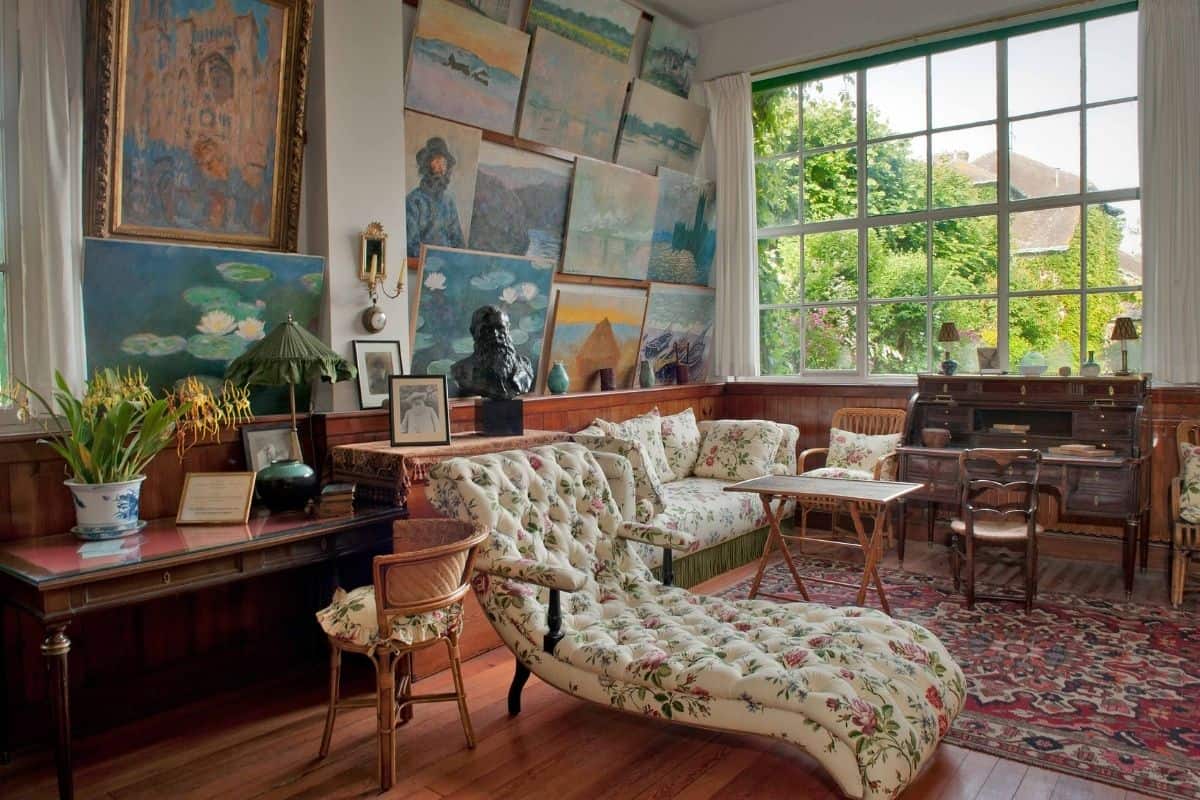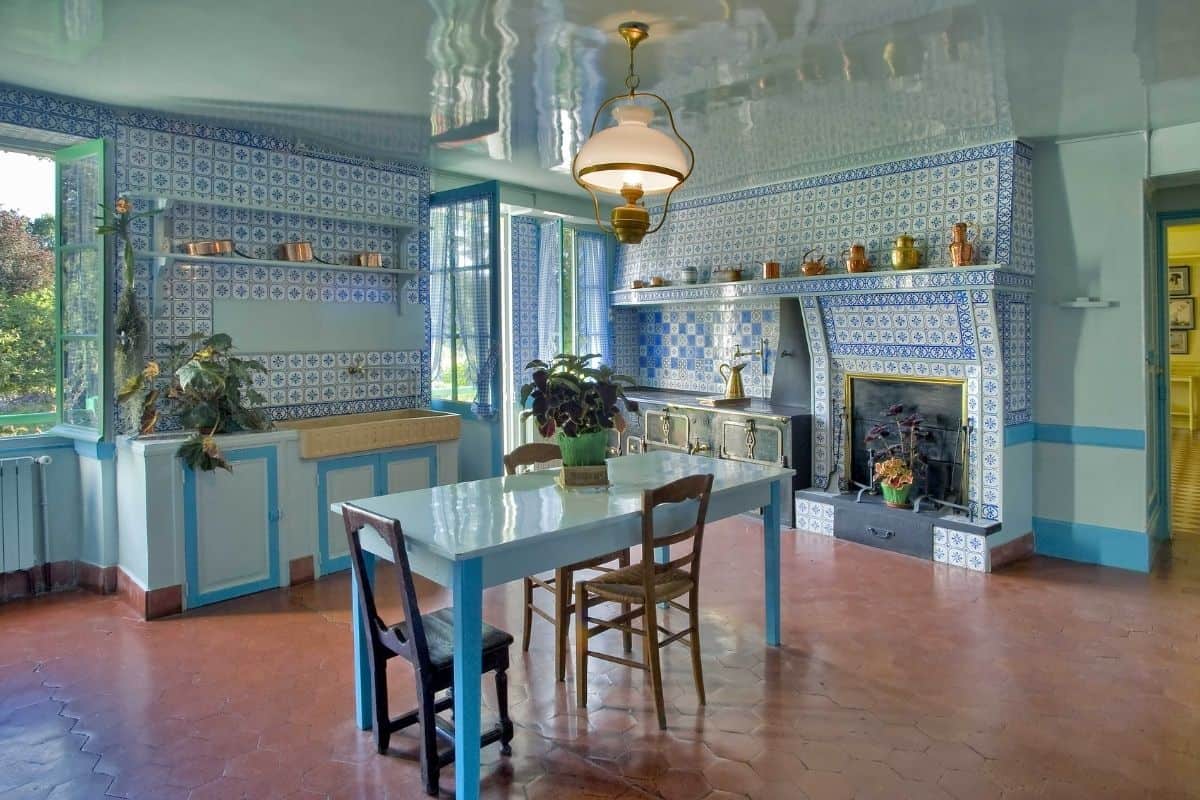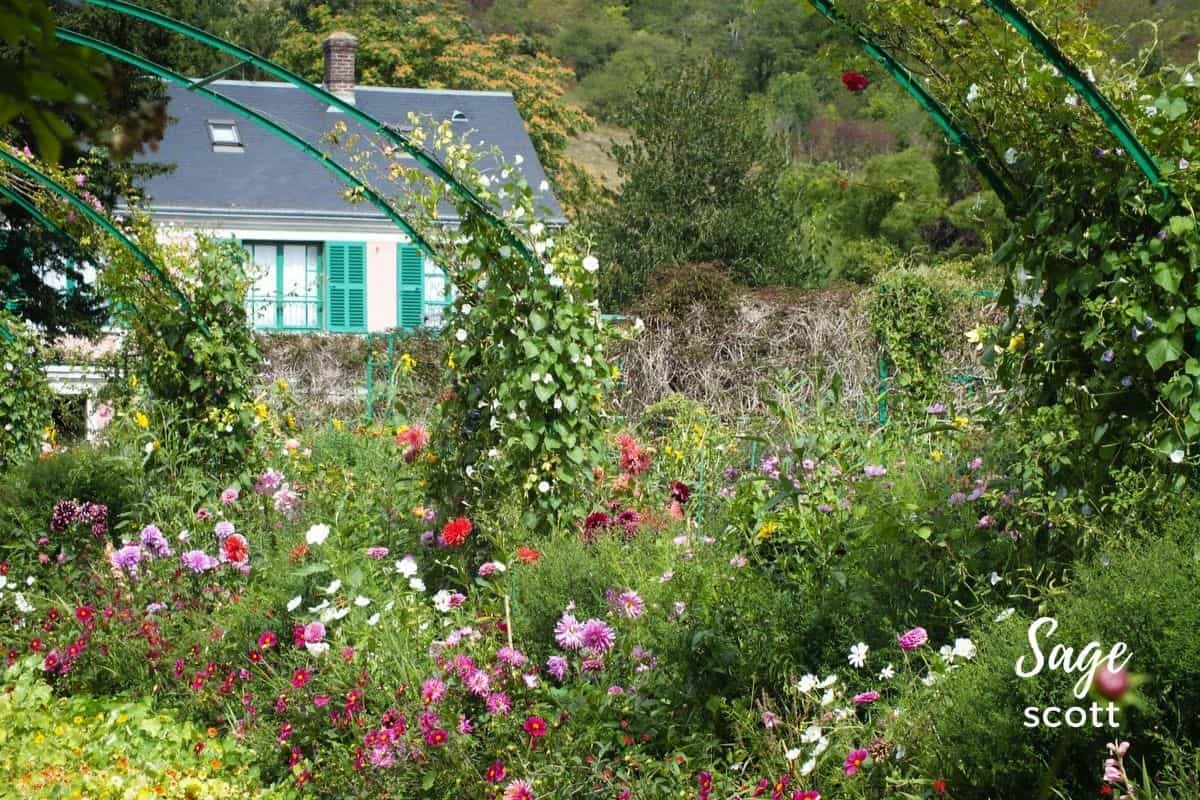In this Article
Toggle

Paris has so much to offer that any excursion outside of the City of Lights seems difficult to fit into an itinerary. But a day trip to Giverny, France, feels like being transported into an Impressionist painting and is worth every minute. Here’s what to expect when you spend the day at the Claude Monet house and gardens in Giverny.
You might have heard me complain in the past that my childhood involved being dragged to every art museum in Europe by my mother. As an adult, I realize that is such a ridiculous complaint. And, I regularly daydream about how fantastic it would be to once again be living in Europe with the same opportunities for regular travel throughout the historic “Old World.” But, as a kid, spending hours in a stuffy, old art museum while my mom — an incredibly talented and curious artist — poured over each piece for what seemed like an hour was pure torture.
Except one destination.
On one of our frequent weekend trips from the Netherlands to France, we spent the day at Claude Monet’s home in Giverny, France. And it was absolutely magical! I had the opportunity to return to Giverny recently as an adult — this time old enough to appreciate all of the opportunities my parents gave us to learn about architecture, art, geography, and history firsthand through travel — and it was just as I’d remembered it.
To help offset the costs of running EverydayWanderer.com, you’ll find affiliate links lightly sprinkled throughout the site. If you choose to make a purchase via one of these links, there’s no additional cost to you, but I’ll earn a teeny tiny commission. You can read all of the legal blah blah blah (as my little niece says) on the full disclosure page.
How to Get to Giverny from Paris
Giverny is a beautiful French village about 50 miles (75 km) northwest of Paris. There are several ways to get to Giverny from Paris.
How to Visit Giverny from Paris by Car
Whether you have your own vehicle or are renting a car, the fastest way to reach Giverny from Paris is via A14 and A13. This route will take about an hour but includes toll roads.
To avoid toll roads, take A15 through Cergy. This option adds about 10 more miles to your journey, but I choose to see that as an opportunity to see more of the picturesque French countryside!
Sage Advice: Unless you know how to drive a manual transmission car, be sure to rent a car with automatic transmission before you travel to France. They are few and far between in Europe!
How to Visit Giverny from Paris by Train
If you prefer to ride the rails, it’s about an hour train ride from Paris’s St. Lazare train station to Vernon (Giverny). This option allows you to sit back and relax rather than navigate the roads. Plus, Monet’s first glimpse of Giverny was from a train, so you’ll have that in common with the master Impressionist if you visit Giverny from Paris this way.
Sage Advice: The Gare de Vernon is about 3.5 miles (or a ten-minute drive) from Monet’s Home and Gardens in Giverny, so be sure you are prepared to take a taxi or catch another ride for that final stretch.
How to Visit Giverny from Paris by Bus
You can also leave the driving to someone else by visiting Giverny from Paris via a guided tour. This half-day trip to Giverny from Paris provides round-trip travel from Paris to Giverny via luxury coach. It also includes a tour of Claude Monet’s beautiful home and lush gardens — including the lily pond and Japanese bridge — with an art historian and skip the line priority admission.
How to Visit Giverny from Paris by Bicycle
A fun alternative to the typical transportation options is a garden bike tour from Paris. In addition to visiting the Monet home and gardens, you’ll enjoy a coach ride through the picturesque wheat fields of Normandy, an opportunity to explore Giverny by bike, and a picnic lunch on the banks of the River Seine. (But before you hit the road, be sure you know these important biking rules.)
Start Out in the Studio on Your Day Trip to Giverny
You’ll start and end your visit to the Claude Monet house and gardens in his main studio, Nymphéas. Repurposed as the Foundation Claude Monet gift and book shop, this is where you can purchase tickets for your visit and explore a collection of Monet-inspired souvenirs from postcards to champagne glasses.

Enjoying This Article?
Sign up for the newsletter!
Thank You for Subscribing!
Let’s Pause Here and Catch Up on the Characters

Three years after their son, Jean, was born, Claude Monet married Camille Doncieux. Whether sitting on a bench or in a garden with their son, Camille was Claude’s muse and featured in many of his early works. Sadly, Camille became ill a few years into their marriage, and the birth of their second son, Michel, weakened her body further. Camille died of tuberculosis in September 1879 at the age of thirty-two, leaving Claude to raise his adolescent and infant sons.
The son of a successful lace and shawl merchant, Ernest Hoschede managed a successful department store in Paris and was an art collector. He was best known for supporting Impressionist artists like Monet, Degas, and Pissarro. It was art that connected the Monets and Hoschedes, the men becoming close friends.
As Camille Monet’s health slowly declined, Ernest Hoschede lived beyond his means and went bankrupt, ultimately abandoning his wife, Alice, and their six children. Because the families were close (so much so that it is rumored that Claude and Alice were having an affair while Camille was still alive), Claude welcomed Alice and her six children into his home in Vétheuil, a town along the Seine northwest of Paris. When Camille passed away, Alice took Monet’s sons back to Paris and raised them with her own six children.
A few years later, in 1883, Claude, Alice, and their Brady Bunch of eight kids — four boys and four girls — moved to Giverny together. Although the family of ten lived together, Claude and Alice didn’t marry for nearly a decade, not until Ernest passed away. At the children’s request, Monet paid for Hoschede’s funeral and burial at Giverny. The following year, Claude and Alice were married.
Now back to our day trip to Giverny to experience Monet’s house and gardens…
Monet’s Pink Adobe Home with Forest Green Shutters
Claude Monet spotted the the small village of Giverny, France, from the doorway of a train taking him from Vernon to Gasny. It must have been love at first sight, because he quickly moved there with his family and in May of 1883 began renting the house he’d make his home for the next 40 years. By 1890, he had enough money to purchase the famous pink stucco dwelling with forest green shutters and the surrounding two acres of land.
Sage Advice: Visitors are not allowed to take photos inside Monet’s house, and they must follow a designated route through the home.
As you approach Monet’s house, you’ll immediately notice its rectangular shape. About half the length of an American football field (45 yards/40 meters), its narrow format forces each room to seamlessly flow into the next.

Main Floor
The main floor starts in the little blue salon. In this bright white room with robin egg blue trim, Monet’s second wife, Alice, would read. This room connects to the small pantry where tea, olive oil, spices, and other cooking essentials were kept in cabinets.

In the room at the end of the main floor, where a wall of windows looks out at the garden, Monet had his first studio. In 1899, it was converted into the cozy sitting room you’ll experience on your day trip to Giverny.
Living Quarters

From the artist’s original studio, you’ll head upstairs to the second floor where Claude, Alice, and their eight children bathed, dressed, and slept. Monet’s bedroom was directly above his studio where it, too, has a prime view of the gardens. Alice stayed in the bedroom next door to Claude. After all, the couple didn’t marry for nearly ten years after moving into the house with their children.
Back Down to Earth
You’ll return to the ground floor to finish your tour in my favorite rooms, the dining room and the kitchen. In addition to the grounds, these two rooms remained as clear as a photograph in my memory all of the years between my visits.

Painted a bright buttercup yellow with checkerboard flooring and Japanese-inspired art, the dining room has glass double French doors that open onto the balcony and frame the garden beyond. Standing in this sunny room, I immediately pictured a lively scene of Monet’s large family lingering over an amazing French meal and passionately discussing art and flowers.

Connected to the dining room is the kitchen, which brings us full circle to the color palette of the first room, the little blue salon. The walls of this room are tiled with blue ceramic squares from Rouen, France, that pair nicely with the white walls and blue trim.

Sage Advice: Looking for another beautiful destination beyond the French capital? Don’t miss Louis XIV and Marie Antoinette’s beautiful Palace of Versailles, a day trip from Paris.
Monet’s Magnificent Flower Garden, Clos Normand

It’s impossible to tour Monet’s house and not be impressed by the perpetual views into the two-acre, walled garden, Clos Normand. With guidance from a large personal library of horticultural books written in French, English, and German, Monet spent decades carefully cultivating the land around his home into the gardens that appear in many of his paintings.
Lush, fragrant, and full of color, you’ll want to allow plenty of time to wander along the crushed gravel path of Monet’s flower garden when you day trip to Giverny. The variety of plants, flowers, and trees carefully selected, planted, and maintained by Monet (along with assistance of the estate’s current gardeners) ensure that Clos Normand blooms constantly as the seasons slowly morph from spring to summer to fall.
In early spring, a kaleidoscope of daffodils and tulips offer color as the last grey days of winter make way for the greenery of spring. You’ll think you’re walking along the tidal basin in Washington, DC, when you see the cherry trees bursting with delicate pink flowers. Guided by the large, green metallic arches installed by Monet, flowering vines begin their march up and over the main path as they prepare to provide shade from the hot summer sun, and the season continues.
Related Article: In Full Bloom: 100+ Beautiful Tulip Quotes
As the spring bulbs bow out, peonies take the stage, connecting spring to summer. Bright poppies add color to Clos Normand in summer while chrysanthemums wait in the wings. They take center stage for the season’s final act, which includes fragrant roses.
And Beloved Masterpiece, the Water Garden

Once you’ve fully consumed Monet’s flower garden, walk to the very edge of the property to see his pride and joy, the water garden. You’ll actually cross under a busy road, chemin du Roy, to get to the water garden, but the thick bamboo forest blocks much of the noise and view, keeping you focused on your immediate surroundings.

To create the water garden, Monet purchased additional land adjacent to his house in 1890 that included a water meadow. With help from the Ru, a narrow arm of the river Epte that he diverted onto his property, he promptly began expanding his newly acquired acreage into the lovely lily ponds featured in a series of his most famous paintings,This work was quite an undertaking, for it took Monet nearly 20 years to create the water garden.

As you stand on the ground where Monet once did, gazing at the clear waters of the pond and admiring the soft flowers of the water lilies, it’s hard not to feel like you have suddenly been transported into one of the master’s paintings. But, if that doesn’t do the trick, the Japanese footbridge will. Painted Monet’s trademark forest green, to differentiate it from the typical red bridge in Japan, the arch that connects two banks of the lily pond is absolutely breathtaking.
Restoring Monet’s Home and Gardens
After Monet’s death in 1926, the gardens around his home slowly deteriorated. In 1976, funded with millions of dollars in donations, former Versailles chief curator Gerald Van der Kemp and his American wife, Florence, began to restore Monet’s home and garden. Today, more than 500,000 people visit the artist’s former estate between March and October.
Visiting Giverny
Where is Monet's House and Gardens?
Claude Monet’s home and gardens are located at 84 Rue Claude Monet, Giverny, France. Giverny is about 90 minutes northwest of Paris.
When are Claude Monet's House and Gardens in Giverny open?
Claude Monet’s house and gardens are open to visitors seasonally from 9:30 am to 6:00 pm, March through October. Here’s how to purchase skip-the-line tickets and schedule a guided tour.
What's the best place to stay near Claude Monet's home and gardens in Giverny?
In the picturesque town of Giverny, stay at La Pluie de Roses. This romantic bed and breakfast is surrounded by lush gardens that feel as if you’ve stepped into a Monet painting. (See photos)
Halfway between Giverny and Paris, you can also embrace the full experience of the French countryside by booking at cottage at les gites du Close Saint-Martin. (See photos)
Search for other hotels in Giverny and explore vacation rentals in Giverny, as well.
Have You Visited Monet's House and Gardens on a Day Trip to Giverny?
What did you like most? Any tips and tricks or advice to pass along from your visit? Share your experiences in the comments section below.
Ready to Go?
Use These Helpful Links to Book Your Trip!
- Find low fares with airfarewatchdog and Skyscanner
- Book your plane ticket with Expedia or Kayak
- Or take the scenic route on an epic road trip in a rental car or an RV from Outdoorsy
- From hotels to private homes, find the perfect accommodation with Hotels.com or Vrbo
- Travel in style with a suitcase, carry-on, backpack, or handbag from eBags
- Save on tickets to attractions, sightseeing tours, and more with CityPASS, Tiqets, and Viator
- Don’t leave home without travel insurance from AXA
- Discover the sights, history, and culture of your destination with an interactive scavenger hunt
- Need something else to plan your perfect trip? Visit my travel resources page for more trusted partners. Happy wandering!
Thank you for sharing!




Have you seen my book, EVERYDAY MONET? https://amzn.to/34DoLYS Aileen Bordman
It all looks exactly like these pictures and Monet’s paintings. The water garden and the kitchen were highlights for me but I loved espresso in the little coffee shop and all the colorful gardens as well.
Isn’t is so gorgeous! I’m glad someone else loved the kitchen as much as I did. If those walls could talk! Thanks for reading my article and sharing your thoughts! <3
This sounds like an amazing trip! I agree, when you’re younger it can be hard to appreciate what’s around you, especially with culture and art ?. But it’s awesome that you got to experience Monet’s house as an adult too! I’ve never been but it sounds like an awesome day trip from Paris!
It’s absolutely beautiful!
That is so stunning that it doesn’t even look real! How fascinating! And such fabulous pictures!
We were in Paris twice and have never visited Giverny. It looks absolutely beautiful! We will have to remember this next time we go back!
The towns of Normandy are so beautiful, especially Giverny! You’ll have to go!